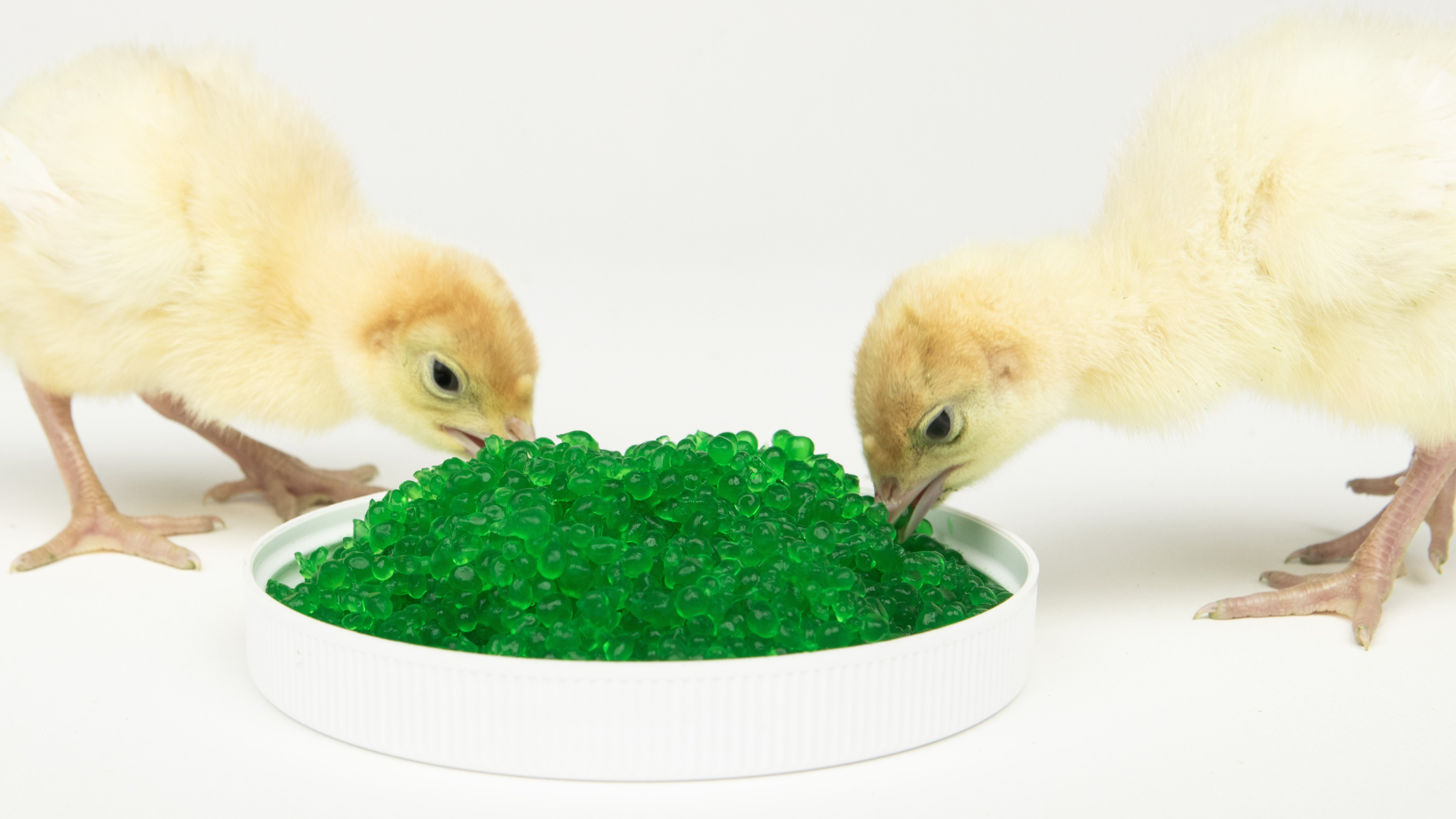Background
AquaBeads®, a hydration and feed-attractant supplement, have been developed to enhance early-stage growth performance and intestinal development in broiler chicks. This study, conducted by the Rochell Poultry Nutrition Lab at the University of Arkansas, evaluated the impact of AquaBeads® application rates and duration on broiler chick intestinal development and nutrient uptake during the first 18 days post-hatch.
Experimental Design
A total of 840 Cobb 500 male chicks were assigned to one of eight treatment groups, with 15 replicate pens per group and seven birds per pen. The treatment groups included: a control group that received only the starter feed without AquaBeads®; three groups that received AquaBeads® at rates of 1, 2, or 3 g/chick/day for a single day; three additional groups that received AquaBeads at rates of 1, 2, or 3 g/chick/day for three consecutive days; and a final group that was given a choice-feeding option, where AquaBeads® were provided separately from the starter feed for three days.
Birds were housed in battery cages and monitored for feed intake (FI), body weight gain (BWG), feed conversion ratio (FCR), and intestinal development. Statistical analysis was performed using PROC GLM in SAS with Tukey’s HSD test for treatment comparisons.
Results
AquaBeads® supplementation had a significant impact on intestinal development, as ad-libitum provision of AquaBeads resulted in an increase in intestinal length and weight as a proportion of body weight when compared to the control group (P<0.05). These findings indicate that AquaBeads® may enhance gastrointestinal development during early stages of growth. In terms of feed conversion efficiency, AquaBeads® supplementation improved feed conversion ratio (FCR) in a linear manner at both days 3 and 7. For example, the FCR improved from 1.08 in the control group to 0.97 in the group receiving 3 g/day for three days (P<0.05), highlighting the potential for AquaBeads® to optimize feed efficiency during early growth periods.
TABLE 1: Growth Performance from 0 to 3 Days
| Item | Control | 1d 1g | 1d 2g | 1d 3g | 3d 1g | 3d 2g | 3d 3g | Ad-lib | SEM | P-Value |
|---|---|---|---|---|---|---|---|---|---|---|
| Initial BW, g | 42.7 | 42.6 | 42.7 | 42.6 | 42.8 | 42.6 | 42.5 | 42.7 | 0.1 | 0.817 |
| FI, g | 43.1 | 35.2 | 36.2 | 34.6 | 36.3 | 32.3 | 33.3 | 35.5 | 1.0 | 0.001 |
| BW, g | 87.7 | 89.6 | 89.9 | 88.9 | 86.0 | 89.9 | 86.6 | 88.6 | 1.3 | 0.160 |
| BWG, g | 45.0 | 47.0 | 47.2 | 46.3 | 43.4 | 47.3 | 43.8 | 45.9 | 1.3 | 0.117 |
| FCR | 0.96 | 0.75 | 0.75 | 0.74 | 0.78 | 0.70 | 0.68 | 0.72 | 0.02 | 0.001 |
TABLE 2: Growth Performance from 0 to 7 Days
| Item | Control | 1d 1g | 1d 2g | 1d 3g | 3d 1g | 3d 2g | 3d 3g | Ad-lib | SEM | P-Value |
|---|---|---|---|---|---|---|---|---|---|---|
| FI, g | 158.8 | 151.1 | 154.5 | 151.9 | 146.2 | 148.2 | 151.9 | 151.9 | 2.7 | 0.072 |
| BW, g | 190.6 | 195.1 | 197.2 | 192.5 | 194.2 | 196.9 | 199.0 | 198.2 | 3.4 | 0.419 |
| BWG, g | 147.9 | 152.5 | 154.5 | 149.9 | 151.6 | 154.4 | 146.6 | 154.6 | 3.4 | 0.440 |
| FCR | 1.08 | 1.00 | 0.97 | 1.02 | 1.03 | 1.01 | 1.05 | 1.00 | 0.01 | 0.001 |
Retention studies showed that AquaBeads® were retained in the crop for approximately 15 minutes before moving to the gizzard, where they remained intact as they passed through the digestive tract. This suggests that AquaBeads® can serve as a stable and reliable source of hydration and nutrition as they progress through the gastrointestinal system. Although there were no significant differences in body weight gain (BWG) across treatments at days 3, 7, or 18, feed intake (FI) was lower in AquaBead®-fed groups (P<0.05), which may reflect a displacement of nutrients from feed.

Conclusion
This study demonstrates that AquaBeads® positively influence intestinal development by increasing intestinal length and weight as a proportion of body weight. Additionally, AquaBeads® improved feed conversion efficiency during early growth stages. While AquaBeads® did not significantly impact body weight gain, their potential to enhance nutrient utilization and gastrointestinal development makes them a valuable supplement for broiler chicks during the critical early stages of growth.
Further research is recommended to refine application rates and durations to optimize benefits without displacing critical feed nutrients.




Leave a comment
All comments are moderated before being published.
This site is protected by hCaptcha and the hCaptcha Privacy Policy and Terms of Service apply.